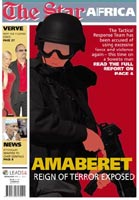The Star Africa is unapologetically black - editor Makhudu Sefara

In the last of a series of interviews with the top editorial managers of Independent Newspapers, The Star's new editor Makhudu Sefara tells Bizcommunity.com why the Africa edition is a bold move to turn around circulation decline - and we should pay attention because he pulled this off at Sunday Independent.
[Scroll to the bottom for links to Q&As with Chris Whitfield in Cape Town and Alan Dunn in Durban.]
 The Star Africa is aimed at the township markets of Gauteng and I know there's lots of soccer in the content mix but what else is there? I'm trying to get an idea of its positioning. Will it be closer to a red-top tabloid?
The Star Africa is aimed at the township markets of Gauteng and I know there's lots of soccer in the content mix but what else is there? I'm trying to get an idea of its positioning. Will it be closer to a red-top tabloid? Makhudu Sefara: It's not tabloid in the traditional sense. It's tabloid in format. We're not doing the Daily Sun [owned by Media24] - the tokoloshes and ghosts, etc. We're aimed at people who read and who take time to think about issues.
 So why go the tabloid route? You could do it as a broadsheet - like The Star's main edition.
So why go the tabloid route? You could do it as a broadsheet - like The Star's main edition. Sefara: Well, we had researchers speaking to a number of people - people who read The Star; people who don't read The Star - [to find out] what their views of The Star are. And quite a number of people said the format is too big... but a tabloid format is easy to manage so we responded to that.
 OK, so what's the print-run for The Star Africa?
OK, so what's the print-run for The Star Africa? Sefara: We're putting out about 40 000. [In the most recent ABC figures - for the last quarter of 2011 - The Star was at 128 683 total circulation, compared with 143 084 in the last quarter of 2010.]
 Joh, that's sizable. This is so interesting because, in the apartheid years, many papers had township editions such as the various Sunday Times Extra editions. All of them (besides the Sunday Times Extra aimed at the Indian market) fell away in the 1990s. I can see the sense in having different edition but aren't you worried that you're going back to those apartheid race divisions?
Joh, that's sizable. This is so interesting because, in the apartheid years, many papers had township editions such as the various Sunday Times Extra editions. All of them (besides the Sunday Times Extra aimed at the Indian market) fell away in the 1990s. I can see the sense in having different edition but aren't you worried that you're going back to those apartheid race divisions? Sefara: No, we already do a balancing act in The Star, for instance, in our sports pages: the main codes are rugby, cricket and soccer and we balance them on any given day and try serve all the people with their disparate interests... With the Africa edition, we are unapologetic about our focus. There will be a bit of rugby here and cricket there, athletics and boxing but essentially it's soccer.
We're positioning the edition slightly above The Sowetan [the tabloid owned by Avusa, with 117 862 total ABC circulation in the last quarter of 2011, down from 125 490 a year earlier] and making it unapologetically black.
 OK, so the stories are township stories - about township life.
OK, so the stories are township stories - about township life. Sefara: Not specifically about township but it's about chronicling black life. You have stories about township people and stories about black people who live in the north of Joburg - and stories that have crossover appeal.
One of the things the readers have been raving about since we launched The Star Africa is our lifestyle section. In the news section, we're going big on politics... In the main edition of The Star we balance politics with human interest stories but the assumption we are making is that a lot of black people are still very much into politics... so politics is the mainstay of the Africa edition.
 Are you guys not worried that the Africa edition might cannibalise the circulation of the main edition?
Are you guys not worried that the Africa edition might cannibalise the circulation of the main edition? Sefara: Ja, we've had long debates about it - which is why the cover price for the Africa edition and main edition is the same. But it is something we're keeping our eyes on and paying attention to the trends.
 And how is The Star Africa being received? It's been something of a soft launch.
And how is The Star Africa being received? It's been something of a soft launch. Sefara: It wasn't a big-budget launch... but the preliminary figures show the launch edition gave us 5000 direct sales. We are now averaging 4500-5000 daily increase on circulation - which, a week later, indicates that our sales have bucked the trend of big sales on launch day and then subsiding shortly afterwards.
This is incredible news for us, even though it is still early days. It shows that those who have seen the product do connect with it at a deeper level... There are reasons to be excited but, for now, I remain cautiously optimistic. The key challenge is always to keep the readers you have before happily going out hunting for more. This is a great start, I think.
 I know Zingisa Mkhuma is content editor of The Star Africa [previously editor of the Pretoria News] and Matshelane Mamabolo (@Tshiliboy) is covering soccer for it. Have you brought in quite a few people for the new edition, then?
I know Zingisa Mkhuma is content editor of The Star Africa [previously editor of the Pretoria News] and Matshelane Mamabolo (@Tshiliboy) is covering soccer for it. Have you brought in quite a few people for the new edition, then? Sefara: Yes, we have. We have a couple of reporters and obviously sub-editors and layout subs. Not everyone was in place before the launch but we will be appointing some more soon.
 The Star has been suffering circulation decline and falling ad revenue - like most papers in SA - for quite some time so is this a major strategy to address these problems?
The Star has been suffering circulation decline and falling ad revenue - like most papers in SA - for quite some time so is this a major strategy to address these problems? Sefara: Ja. We've had something called The Star Soweto edition for some time, which has been a major success for us. As The Star was losing circulation here and there, it was gaining in Soweto.
So we decided to expand from Soweto into other townships... and to other provinces. We're hoping The Star Africa will help in a big way to deal with circulation decline.
 What other provinces? Around Gauteng?
What other provinces? Around Gauteng? Sefara: Ja, we're putting The Star Africa out to Limpopo and Mpumalanga already. And we're looking at extending the footprint to the North West and the Free State but the logistics around these are still being worked out.
 This is only your second month as editor of The Star[(previously Sefara was editor of the Sunday Independent] so this must have been challenging?
This is only your second month as editor of The Star[(previously Sefara was editor of the Sunday Independent] so this must have been challenging? Sefara: Ja, trying to adjust to the rhythm of The Star was challenging. At the Sunday Indy, you're doing four big lead stories a month but here you're already on deadline when you arrive in the morning. It's a different rhythm and I've been meeting with the different stakeholders, trying to get my head around who is doing what where - the first three weeks were quite hectic and it was 12-hour days in the office...
At the end of the day you're tired but when you see the product in your hands, you feel energised. It's exciting. There are so many things to do but when everything falls into place and the presses start running - and what was an idea has now been concretised - you can look at the product and say: "You know, this thing has come together quite beautifully."
 I presume the Africa edition has been in the planning for a while so you had to catch up on all of this.
I presume the Africa edition has been in the planning for a while so you had to catch up on all of this. Sefara: No, I've been involved since the beginning - it's something we've been talking about at our exco for a while, since last year.
 The Star broadsheet must have a majority black readership, surely? It must be about 60% or 70%?
The Star broadsheet must have a majority black readership, surely? It must be about 60% or 70%?Sefara: Ja, it's about 60%.
 OK, so what did the market research say about black readers in the townships. Why were they not buying The Star in its broadsheet form?
OK, so what did the market research say about black readers in the townships. Why were they not buying The Star in its broadsheet form? Sefara: It's a perception. People still look at The Star as a white paper and the Sowetan as a black paper... When we did The Star Soweto edition, people responded in numbers.
 And are these new readers or are these readers of The Sowetan?
And are these new readers or are these readers of The Sowetan? Sefara: I'm not certain. One of the things we have done is to consistently check on the number of stories about Soweto in the Sowetan. Consistently we have found that the Sowetan doesn't really carry very much of what is happening in Soweto.
So I'm not sure if the people who suddenly started buying The Star Soweto edition were disgruntled former Sowetan readers or they were people who felt this was a product that talked to them and suddenly started buying it.
 Let's talk about the Sunday Independent. When I interviewed you two years ago and you had been the Sunday Indy's editor for five months, your aim was to get the paper to 40 000. And you got very close [to 39 129 total circulation in the last quarter of 2011, compared with 34 329 two years earlier]. That is a little talked-about publishing success, especially considering how everyone is on the decline.
Let's talk about the Sunday Independent. When I interviewed you two years ago and you had been the Sunday Indy's editor for five months, your aim was to get the paper to 40 000. And you got very close [to 39 129 total circulation in the last quarter of 2011, compared with 34 329 two years earlier]. That is a little talked-about publishing success, especially considering how everyone is on the decline. Sefara: I think the story that is not told about the Sunday Independent is that, when I arrived, there was also bulking and PMIE [Print Media in Education that goes to schools]. As our numbers increased, we took away the creative ways of boosting circulation. [In the last quarter of 2011, for instance, the ABC figures show that the Sunday Indy had no bulk, PMIE or sales below 50% of cover price.] So the paper was standing on its own.
It was a hectic two years but it was exciting to see how people responded to the paper...
 Ja, the two local papers that stand out in terms of sustained circulation gains over the past two years are the Sunday Independent and the Mail & Guardian.
Ja, the two local papers that stand out in terms of sustained circulation gains over the past two years are the Sunday Independent and the Mail & Guardian. Sefara: Ja, and the story that it tells is that the media landscape has changed in a big way. And editors of daily papers need to wake up to this, too. People have access to information - especially to announcements such as Julius Malema being shown the door by the ANC or COSATU marching against tolls and labour brokers.
The days of being a paper of record are over as those stories are told live on the day - on TV and radio, social media and the like. By the time you publish your paper the following day, you need to find a way of throwing your stories forward.
What we tried to do at the Sunday Independent was to try find our own unique stories. That's a difficult task - some weeks we succeeded; some we didn't - and clearly that's what the Mail & Guardian tries to do. I think this is the way of the future.
 Obviously, you're going to strive to do this with The Star too. That's much harder to do at a daily newspaper.
Obviously, you're going to strive to do this with The Star too. That's much harder to do at a daily newspaper.
Sefara: Yes, it's a mission to be able to do that every day but it's something that we have to do or else we'll have big problems.
- Bizcommunity: Watching Argus move for Daily News future - Indy KZN's Alan Dunn, 2 April 2012
- Bizcommunity: Chris Whitfield on balancing act of Cape Argus move, 12 March 2012
For more:
- Bizcommunity: Newspapers dire but not dead, say latest ABC circ numbers, February 2012
- IOL: Independent Newspapers reshuffle, February 2012
- Grubstreet: Sunday paper shake-up: Grubstreet speaks to Sunday Independent's Mahkudu Sefara, February 2010
- Google News Search: "The Star Africa"
The Star Sowetan corrected to The Star Soweto at 9.18am on 18 April 2012. Bizcommunity.com regrets the error.
About Gill Moodie: @grubstreetSA
View my profile and articles...


